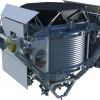3 Ways We Use Magnets For Space Exploration
We use magnets in a variety of ways when it comes to studying and traveling in space.. From satellites to landing on the moon, magnets play a key role in the equipment used for space exploration. Here are three different examples of how we use magnets to learn more about outer space.
-
Magnetic Torquers
-
Magnet Motor
-
Alpha Magnetic Spectrometer

